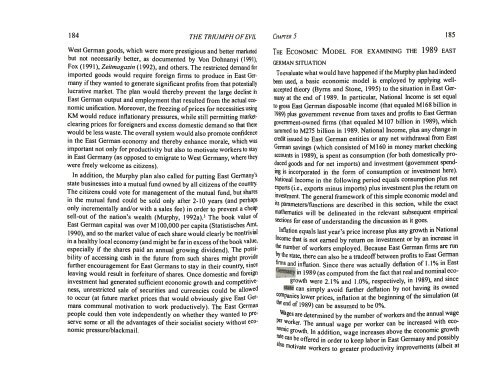austin-murphy-the-triumph-of-evil
austin-murphy-the-triumph-of-evil
austin-murphy-the-triumph-of-evil
You also want an ePaper? Increase the reach of your titles
YUMPU automatically turns print PDFs into web optimized ePapers that Google loves.
184 THE TRIUMPH OF EVIL<br />
West German goods, which were more prestigious and better marketed<br />
but not necessarily better, as documented by Von Dohnanyi (1991),<br />
Fox (1991), Zeitmagazin (1992), and o<strong>the</strong>rs. The restricted demand for<br />
impo�ed goods would require foreign firms to produce in East Ger<br />
many _ If <strong>the</strong>y wanted to generate significant pr<strong>of</strong>its from that potentially<br />
lucrative market. The plan would <strong>the</strong>reby prevent <strong>the</strong> large decline in<br />
East German output and employment that resulted from <strong>the</strong> actual eco<br />
nomic unification. Moreover, <strong>the</strong> freezing <strong>of</strong> prices for necessities using<br />
KM � ould _ reduce inflationary pressures, while still permitting market<br />
cleanng pnces for foreigners and excess domestic demand so that <strong>the</strong>re<br />
�ould be less waste. The overall system would also promote confidence<br />
� n <strong>the</strong> East German economy and <strong>the</strong>reby enhance morale, which was<br />
Important not only for productivity but also to motivate workers to stay<br />
in East Germany (as opposed to emigrate to West Germany, where <strong>the</strong>y<br />
were freely welcome as citizens).<br />
In addition, <strong>the</strong> Murphy plan also called for putting East Germany's<br />
state businesses into a mutual fund owned by all citizens <strong>of</strong> <strong>the</strong> country.<br />
The citizens could vote for management <strong>of</strong> <strong>the</strong> mutual fund but shares<br />
.<br />
m th � mutual fund could be sold only after 2- 10 years (and perhaps<br />
only mcrementally and/or with a sales fee) in order to prevent a cheap<br />
sell-out <strong>of</strong> <strong>the</strong> nation's wealth (Murphy, 1992a).l The book value <strong>of</strong><br />
East German capital was over M 100,000 per capita (Statistisches Amt,<br />
! 990), and so <strong>the</strong> market value <strong>of</strong> each share would clearly be nontrivial<br />
m a healthy local economy (and might be far in excess <strong>of</strong><strong>the</strong> book value,<br />
especially if <strong>the</strong> shares paid an annual growing dividend). The possi·<br />
bility <strong>of</strong> accessing cash in <strong>the</strong> future from such shares might provide<br />
furt�er encouragement for East Germans to stay in <strong>the</strong>ir country, since<br />
leavmg would result in forfeiture <strong>of</strong> shares. Once domestic and foreign<br />
investment had generated sufficient economic growth and competitive·<br />
ness, unrestricted sale <strong>of</strong> securities and currencies could be allowed<br />
to occur (at future market prices that would obviously give East Ger·<br />
mans communal motivation to work productively). The East German<br />
people could <strong>the</strong>n vote independently on whe<strong>the</strong>r <strong>the</strong>y wanted to pre·<br />
serv � some or all <strong>the</strong> advantages <strong>of</strong> <strong>the</strong>ir socialist society without eco<br />
nomic pressure/blackmail.<br />
'<br />
CHAPTER 5<br />
185<br />
THE ECONOMIC MODEL FOR EXAMINING THE 1989 EAST<br />
GERMAN SITUATION<br />
To evaluate what would have happened if <strong>the</strong> Murphy plan had indeed<br />
been used, a basic economic model is employed by applying well<br />
accepted th.eory (Byrns and Stone, 1995) to <strong>the</strong> situation in East Germany<br />
at <strong>the</strong> end <strong>of</strong> 1989. In particular, National Income is set equal<br />
to gross East German disposable income (that equaled Ml68 billion in<br />
1989) plus government revenue from taxes and pr<strong>of</strong>its to East German<br />
government-owned firms (that equaled Ml07 billion in 1989), which<br />
summed to M275 billion in 1989. National Income, plus any change in<br />
credit issued to East German entities or any net withdrawal from East<br />
German savings (which consisted <strong>of</strong>M160 in money market checking<br />
accounts in 1989}, is spent as consumption (for both domestically pro<br />
duced goods and for net imports) and investment (government spend<br />
ing is incorporated in <strong>the</strong> form <strong>of</strong> consumption or investment here).<br />
National Income in <strong>the</strong> following period equals consumption plus net<br />
� xports (i.e., exports minus imports) plus investment plus <strong>the</strong> return on<br />
�vestment. The general framework <strong>of</strong> this simple economic model and<br />
Its parameters/functions are described in this section, while <strong>the</strong> exact<br />
ma<strong>the</strong>matics will be delineated in <strong>the</strong> relevant subsequent empirical<br />
sections for ease <strong>of</strong> understanding <strong>the</strong> discussion as it goes.<br />
Inflation equals last year's price increase plus any growth in National<br />
Income that is not earned by return on investment or by an increase in<br />
�he number <strong>of</strong> workers employed. Because East German firms are run<br />
Y <strong>the</strong> state, <strong>the</strong>re can also be a trade<strong>of</strong>f between pr<strong>of</strong>its to East German<br />
firms and inflation. Since <strong>the</strong>re was actually deflation <strong>of</strong> 1.1% in East<br />
G�y in 1989 (as computed from <strong>the</strong> fact that real and nominal eco<br />
;:nlc growth � ere 2.1% and 1.0%, respectively, in 19�9), _ and since<br />
state can simply avoid fur<strong>the</strong>r deflation by not havmg Its owned<br />
��panies lower prices, inflation at <strong>the</strong> beginning <strong>of</strong> <strong>the</strong> simulation (at<br />
end <strong>of</strong> 1989) can be assumed to be 0%.<br />
Wages are determined by <strong>the</strong> number <strong>of</strong> workers and <strong>the</strong> annual wage<br />
per �orker. The annual wage per worker can be increased with eco<br />
�te can be <strong>of</strong>fered in orde; to keep labor in East Germany and possibly<br />
nomic growth. In addition wage increases above <strong>the</strong> economic growth<br />
a 80 motivate workers to greater productivity improvements (albeit at


